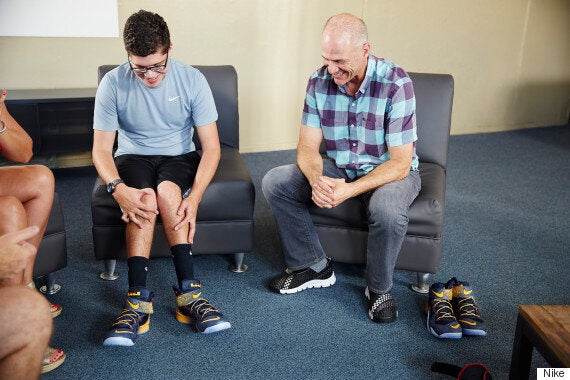For college sophomore Matthew Walzer, simply putting on his shoes was an impossible task. Lacking the dexterity to get his foot in and out of his shoes, the Florida teen, who was born with cerebral palsy, had to enlist the help of his mother and father or others. While he could dress himself, Walzer, 19, told The Huffington Post, “shoes were the one issue” he had learned to deal with and accept.
Until he wanted change.
“By the time you turn 16," he said, "it gets frustrating or embarrassing if you're out with your friends and your shoe comes untied and you have to ask your friend, ‘Hey, can you bend down and tie my shoe for me?’”
So he decided to do something about it. Walzer, then in high school, sent a letter to Nike, first reaching out in 2012. He was intimidated, he said, but persistent.
“It took me a couple years to kind of just figure out exactly what I wanted to say in the right way,” he said.
But luckily for Walzer, his letter ended up in the hands of Nike CEO Mark Parker, who in turn passed it along to Tobie Hatfield, the company’s senior director of athlete innovation. Coincidentally, Hatfield had just embarked on his own journey to explore what Nike could do to help athletes facing physical challenges as well as the Challenged Athletes Foundation.
What resulted in the three years since was a partnership between Walzer and Hatfield’s team at Nike that culminated Monday with the company's unveiling of the Zoom Soldier 8 Flyease. The shoe is the first of its kind for the company, and perhaps any athletic brand specifically designed and dedicated to help those with disabilities and difficulties of buying and wearing shoes. It will be available July 16 in limited quantities at Nike.com for North America.

“We used Matthew as a muse, which was awesome because he couldn’t believe that a big company would do something for him,” Hatfield told HuffPost.
Hatfield began his work in developing shoes and technology for athletes with disabilities back in 2006 with Sarah Reinertsen, a professional paratriathlete, whose leg was amputated when she was 7 years old.
“She was mentioning how much of a hassle it is to buy a pair of shoes, cut the shoe ... and fit it and glue it on, velcro it on, tape it on, all that kind of stuff,” Hatfield recalled. “She was like, really sheepishly, ‘Do you think, you could maybe help?’ And I looked at it and I said, ‘Damn, Sarah, you have to do all of that?’”
Hatfield said that while Reinertsen struggled, she acknowledged the greater difficulties faced by other amputees she worked with who didn’t have the support system of a professional athlete.
“She said the hassle factor was too high, that they wouldn’t even get out and be active because of it. And I said, ‘That’s just not acceptable. We can do better,’” Hatfield said.
Nike Sole, a foam cover for the carbon fiber prosthetic blade developed in 2012, is now used by amputees like Reinertsen and others while competing or participating in physical activity.
However, the technology that wasn't the only groundbreaking factor. The company's distribution of the product proved innovative as well. For the first time in its history, Nike handed over the intellectual property of a design to another organization -- Össur, an orthopaedics and prosthetics company.
“They know their consumer base way better than we do,” Hatfield said.
From there, he began to learn about other challenged athletes -- “not just amputees, but people with cerebral palsy, people with diabetes” -- and to work toward solutions to make their lives easier. It was also an area that hit close to home for the Nike family, after Jeff Johnson, the company’s first employee suffered a stroke in 2004, subsequently losing use of the right side of his body.
“He couldn’t put his shoes on because of that, he couldn’t tie them. So, similar to cerebral palsy where you lose your dexterity, you lose the feeling and you the ability essentially -- what we take for advantage, to put shoes on and to tie them -- they couldn’t tie them,” Hatfield said.
With Walzer’s letter, success with Reinertsen and the motivation to help Johnson, Hatfield created Flyease technology, which, he says, allows for rear entry and no laces to tie, while still managing to provide support.
“Easy entry, easy access, easy adjustment, easy closure,” he said of the shoe.